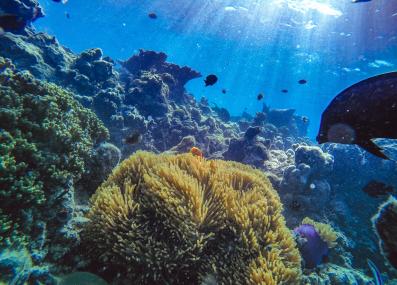New to climate change?
Ocean Alkalinity Enhancement
Ocean alkalinity enhancement is a method to remove carbon dioxide (CO2) from the atmosphere and store it in the ocean by changing the chemistry of seawater. It is one of several “carbon removal” techniques that help address climate change by drawing down CO2, the most important climate-warming greenhouse gas humans are adding to the atmosphere.
Extending a natural process
The ocean already absorbs around 25% of the CO2 humans add to the atmosphere—an astonishing 2.8 billion tons of carbon each year.1
This absorption happens through chemical reactions between air and seawater at the ocean surface. When CO2 enters the ocean, it reacts with water to form carbonic acid. Like all acids, this carbonic acid gives off hydrogen ions, which react with other, “alkaline” molecules in the water that can receive those ions. In the end, the carbon from the CO2 forms stable bicarbonate and carbonate ions.
This has the benefit of slowing climate change. However, it also makes the ocean more acidic, with dangerous consequences for marine life. A more acidic ocean also gradually loses its ability to keep absorbing CO2 from the atmosphere. Hence, if we could make the ocean more alkaline, we could increase the “CO2 capacity” of the ocean, further slow climate change, and reverse some of the harmful ocean acidification caused by our CO2 emissions.2
Alkalinity enhancement
Natural ocean alkalinity is driven by alkaline minerals, such as calcium carbonate, found in shells of microbes, corals and shellfish. Some rocks, such as olivine and basalt, also contribute to ocean alkalinity. As these minerals dissolve in seawater, they give off the alkaline ions that let the ocean absorb CO2.
Altogether, the ocean holds an estimated 37 trillion tons of carbon this way.1 This is a truly massive amount: if all the excess CO2 humans have added to the atmosphere over the past 150 years could be moved to the ocean, it would make up less than 1% of the ocean’s carbon.
These natural processes, however, are very slow, as the dissolution of minerals takes many thousands of years.3 To accelerate this process, scientists are working on approaches to safely add more alkaline substances to the ocean, in forms that react with seawater quickly. This could include grinding naturally occurring minerals like olivine and distributing them in the ocean (a form of “enhanced rock weathering”).3 Some alkaline industrial products are also being studied—whether made deliberately for this purpose, like lime, or waste products like steel slag and cement kiln dust. These materials would need to be distributed at large scale in the ocean, whether through ships, pipelines, or by spreading them on beaches.
Emerging approaches include treating seawater in an electrochemical reactor, powered by renewable electricity.4-7 Inside the reactor, seawater is converted into an acidic and an alkaline stream.5,8 The alkaline stream can be returned directly to the ocean for alkalinity enhancement. Meanwhile, the acidic stream can be used to dissolve alkaline minerals much faster than natural processes. This stream, too, can then be reintroduced to the ocean without negative effect.4,7 Electrochemical reactors could do this work aboard ships, or in facilities like desalination plants that already handle large amounts of seawater.
Challenges
There are large obstacles to performing ocean alkalinity enhancement at the vast scale needed to measurably slow climate change. Imagine a process in which thousands of tons of rock are mined, ground to powder, transported to the ocean and then distributed by ship. Each step in that process comes with substantial costs. Each step also takes energy, mostly from fossil fuels, which create their own climate-warming CO2 emissions. To be useful, ocean alkalinity enhancement must store more carbon than it emits.3
It’s also crucial that this process not do more harm than good to human health or ocean life. While ocean alkalinity enhancement can reduce acidification, unintended consequences could also arise, such as impacts on marine ecosystems, nutrient cycles, or local water chemistry. The sites where alkaline materials are deposited would need to be carefully monitored, both for harmful side effects, and to measure how much CO2 is actually absorbed.3
All this requires careful study before ocean alkalinity enhancement is tried at large scale, along with regulation and governance to ensure it is done responsibly. International cooperation and oversight are needed to manage risks and ensure that projects are aligned with global climate goals.3
If these challenges can be overcome, ocean alkalinity enhancement could be a crucial tool for addressing climate change and countering ocean acidification. Experts agree that, to meet the world’s targets for limiting climate change, some amount of carbon removal will be needed in the coming years.7 All our ideas for doing this are still unproven at scale. Continued research and engineering will pursue the safest and most realistic approaches to ocean alkalinity enhancement, including to minimize the costs and energy use of every step from preparing minerals to the electrochemical systems used to treat seawater.8
December 12, 2024.
1 Friedlingstein, Pierre, et al., "Global Carbon Budget 2023." Earth System Science Data, Volume 15, December 2023, doi:10.5194/ESSD-15-5301-2023.
2 Emerson, Steven R. and Roberta C. Hamme, "Chemical Oceanography: Element Fluxes in the Sea." Cambridge University Press, 2022.
3National Academy of Sciences: "A Research Strategy for Ocean Carbon Dioxide Removal and Sequestration." The National Academies Press, 2022.
4 Tyka, Michael D., Christopher Van Arsdale, and John C. Platt, "CO2 capture by pumping surface acidity to the deep ocean." Energy & Environmental Science, Issue 2, 2022, doi:10.1039/D1EE01532J
5 Kim, Seoni, et al., "Asymmetric chloride-mediated electrochemical process for CO2 removal from oceanwater." Energy & Environmental Science, Issue 5, 2023, doi:10.1039/D2EE03804H.
6 Aleta, Prince, et al., "Direct ocean capture: the emergence of electrochemical processes for oceanic carbon removal." Energy & Environmental Science, Issue 11, 2023, doi:10.1039/D3EE01471A.
7 La Plante, Ericka Collagon. et. al., "Saline Water-Based Mineralization Pathway for Gigatonne-Scale CO2 Management." Energy Gate, Volume 9, Issue 3, 2021, doi:10.1021/acssuschemeng.0c08561.
8 Dickhardt, F. J., et al., "Thermodynamics of Electrochemical Inorganic Marine Dioxide Removal." Environmental Science and Technology, 2024, doi:10.1021/acs.est.4c05721.










